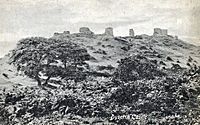Dyserth Castle facts for kids
Quick facts for kids Dyserth Castle |
|
|---|---|
| Part of Denbighshire | |
| Dyserth, Wales | |

Remains of Dyserth Castle in 1917.
|
|
| Coordinates | 53°18′27″N 3°24′35″W / 53.3076°N 3.40978°W |
| Type | Enclosure castle with gateway donjon. |
| Height | Up to 10 metres (33 ft) |
| Site information | |
| Owner | Cadw |
| Controlled by | The Crown |
| Condition | Ruin |
| Site history | |
| Built | First phase c. 1238 Second phase c. 1241 |
| Built by | Henry III |
| In use | Open to public |
| Materials | Limestone ashlar |
| Demolished | 1263 |
Dyserth Castle (Welsh: Castell Diserth) is an old castle site in Denbighshire, Wales. It sits on a high ridge north of the village of Dyserth. This castle was an important part of the defenses on the Clwydian hills during the Middle Ages. The village of Dyserth actually got its name from the castle itself. Today, it is a protected historical site.
Contents
What is Dyserth Castle?
Dyserth Castle has had many names over time, like Castell Diserth, Castle of the Rock, and Dincolyn. It is built on a tall rock made of limestone, less than a mile from the village. People have lived and built defenses on this spot for a very long time.
Archaeologists have found signs of four different times when people used this hill as a fort. These include the Neolithic (New Stone Age), Bronze Age, Romano-British (Roman times in Britain), and the Middle Ages. There are even old stories about a fort called "Castell Dincolyn" being here before the Normans arrived.
When Was Dyserth Castle Built?
In 1240, a powerful Welsh prince named Llywelyn the Great died. After his death, the English king, Henry III, started to take more control over Wales. He launched three military campaigns to expand his lands. To make sure they kept control, the English began building new castles and rebuilding older ones.
Dyserth Castle was one of these important castles. It was meant to replace an older fort at Twthill and work with Deganwy Castle. The exact start of Dyserth Castle's building is a bit unclear. A castle might have been started around 1238 near the current spot. This first castle wasn't quite right. So, in 1241, King Henry III either completely rebuilt it or made it much stronger. This turned it into a powerful English fort.
Who Lived at Dyserth Castle?
Sir Robert Pounderling, an English knight, was in charge of Dyserth Castle from 1241 to 1263. There's a story that he once had one of his eyes hurt by a Welshman during a friendly competition at the castle. Later, the same Welshman challenged him again, but Sir Robert said no! He didn't want to lose his other eye.
A Welshman named Einion, son of Rhirid Flaidd, was killed during a battle at Dyserth Castle in 1263. A stone cross, called "Bryn Einion," was put up where he died. This cross has strange lines and letters carved into it. An old manuscript says the hidden message means: "THAT NEAR HERE THE CAUSE HIS FALL, IF THEY ASK OF SECRET WRITING | REMEMBER EINION, THIS IS THE SON OF RIRID VLAIDD."
What Did Dyserth Castle Look Like?
Dyserth Castle was built in a very good spot for defense. It was on a mountain ridge at the northern end of the Clwydian hills. This location made it naturally strong.
The castle had a small inner courtyard. You would enter this courtyard through a gatehouse that had two towers. The castle also had an outer wall that went all the way around, like a circle within a circle. Some historians believe this might have been one of the first castles in Wales to use this kind of "concentric" design. Dyserth Castle was the last of the British defense castles on the Clwydian hill range during the Middle Ages.
What Happened to Dyserth Castle?
The Welsh first attacked Dyserth Castle around 1245. Over the next nearly 20 years, it was attacked many times. Both the English and the Welsh took control of it at different points.
In 1263, the Welsh prince Llywelyn ap Gruffudd led a long attack on the castle. After several weeks of fighting, the castle was completely destroyed. Much later, during World War I, the ridge where the castle stood was used as a quarry. This meant that many of the remaining castle ruins were removed for stone.
Images for kids


